 |
 |
 |
 |
|
 |
 |
 |
 |
 |
 |
 |
 |
QUESTION & ANSWER (EXECUTIVE OUTLOOK)
 |
 |

FAIRCHILD SEMICONDUCTOR INTERNATIONAL, INC. AND SUBSIDIARIES |

Kirk Pond, Chairman, President, and Chief Executive Officer, discusses Fairchild’s future with Joe Martin, Executive Vice President and Chief Financial Officer.
 Kirk, you have positioned Fairchild as the leading multi-market supplier of integrated circuits. What do you mean by multi-market? Kirk, you have positioned Fairchild as the leading multi-market supplier of integrated circuits. What do you mean by multi-market?

|
 |
 |
 |
 |
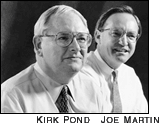 |
Kirk: I mean that we provide high-performance building block semiconductors that are used in a large variety of products—from cell phones to laptop computers to home entertainment to Internet servers. Rather than focus on a specialized product with a limited purpose, our products are used almost everywhere, in every end market. To be honest, when we initiated this multi-market strategy we had plenty of skeptics in the industry. But it’s been very successful and is now being emulated by competitors. |
|
 |
 |
 |
 |
 |
 |
 |
 |
|
 Where did you get the vision, or inspiration, for this approach? Where did you get the vision, or inspiration, for this approach?
Kirk: Before we created Fairchild as an independent company, Joe and I worked together at National Semiconductor. For ten years, we ran successful product lines that were profitable, but could not meet their potential because they didn’t fit with National’s strategy. We recognized that these product lines had significant potential for revenue, profitability, and growth, if they were run under a different business model. When we had the chance to organize the purchase of this business, we knew where we wanted to go, and we were confident we had a business model that would succeed.
|
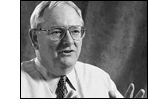 |

 Joe, can you talk a little more about this model? Joe, can you talk a little more about this model?

|
 |
 |
 |
 |
 |
Joe: Sure. Our focus on high-performance building block semiconductors diversifies our customer base and gives our products a long lifetime, usually 10–15 years. As an example, we may develop a product for a cell phone, then turn around and sell the same product into a laptop computer, then maybe into a palm computer. The nature of these products allows us to be able to grow our business while spending less on R&D and SG&A. Our below-the-line spending is typically 15–20 percent of sales, compared to 25–30 percent of sales for semiconductor manufacturers who supply system-on-a-chip (SOC) products. Even though our gross margins may be lower than some SOC suppliers, our operating profits as a percent of sales are basically equivalent.
 |
|
 |
 |
 |
 |
 |
 |
 |
 |
|
 Kirk, what would you say are the benefits of this multi-market strategy? Kirk, what would you say are the benefits of this multi-market strategy?
Kirk: One key benefit is diversity. Because we serve many markets we’re less affected by a downturn in
any specific market. A critical element of this strategy is that we develop innovative products for electronic applications and functions which are not limited to specific end markets.
Joe: Another obvious factor is our high free cash flow. Since most of our products don’t require cutting edge small lithography manufacturing, we can grow our business on capital spending of only 10–12 percent of sales, whereas the industry average is almost twice that.
|
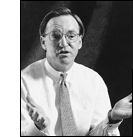
 |
 |
|
|
 |
 |
 |
 |
   
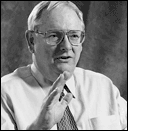 |
 Let’s talk about acquisitions. You say they are a key part of your growth strategy. Let’s talk about acquisitions. You say they are a key part of your growth strategy.
Kirk: Yes, they are. We believe our current product portfolio addresses a market worth about $30 billion in 1999. That means our market share is about 3–4 percent. We believe the total multi-market segment will grow to about $60 billion by 2002, and we plan to continue to be a leader in that segment. Our goal is to be a 10 percent player, and we know we can only get there by combining rapid internal growth with key acquisitions.
 What’s your approach to looking at acquisitions? And what are your financial parameters? What’s your approach to looking at acquisitions? And what are your financial parameters?
|
|
 |
 |
 |
 |
 |
 |
 |
 |

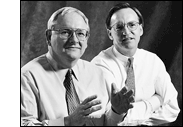 Kirk: Strategically, we want to expand our product portfolio, our regional sales coverage, and our end market penetration. Any business we acquire must fit these requirements. And, we would like to acquire manufacturing assets as part of any deal. That’s exactly what we did with our Raytheon and Power Device acquisitions. We’ve examined more than 100 opportunities over the last three years, and our effort continues. We have found that the most likely candidates are not publicly traded companies, but “carve-outs” of multi-market semiconductor businesses that are buried within larger semiconductor or electronics manufacturers. In many cases, these other companies have a strategic focus that doesn’t include investing in their multi-market products. Kirk: Strategically, we want to expand our product portfolio, our regional sales coverage, and our end market penetration. Any business we acquire must fit these requirements. And, we would like to acquire manufacturing assets as part of any deal. That’s exactly what we did with our Raytheon and Power Device acquisitions. We’ve examined more than 100 opportunities over the last three years, and our effort continues. We have found that the most likely candidates are not publicly traded companies, but “carve-outs” of multi-market semiconductor businesses that are buried within larger semiconductor or electronics manufacturers. In many cases, these other companies have a strategic focus that doesn’t include investing in their multi-market products.
Joe: We often can offer a win-win scenario…we can economically acquire and grow a business that’s strategically important to us…while the parent company we do the carve-out with can invest the value they receive into furthering their focus strategies. As far as financial parameters, it’s pretty simple: we would like any acquisition we make to be accretive to earnings. Kirk and I, like all Fairchild stockholders, are determined to see this company grow through sound financial decisions.
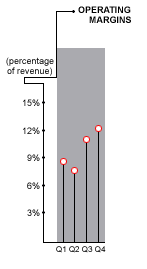 |
 Beyond acquisitions, what’s your major thrust for this year, 2000? Beyond acquisitions, what’s your major thrust for this year, 2000?
Kirk: We’ve launched what we call Phase II…an acceleration of our growth strategy. We’re increasing our R&D investments, focusing on developing products that manage power, convert power, and route power in many different end markets. These products handle power from the wall outlet all the way down to the circuit board. We’re also investing to grow our position in the Interface market, with products that speed data transmission on motherboards and backplanes.
Joe: We’re raising our capital spending to about 15% of sales in 2000, investing in all our manufacturing sites to increase production capacity. We are running at full capacity now, partly due to the success of our new products. We will be increasing capacity across all of our facilities, mainly through purchases of tooling…very little new brick and mortar. Our capital efficiency gives us the capacity to realize more than two dollars of revenue for each dollar of capital we spend.
|
 Graph represents calendar 1999 and includes pro forma results from acquisition of the Power Device business (excludes restructuring and other non-recurring charges). Graph represents calendar 1999 and includes pro forma results from acquisition of the Power Device business (excludes restructuring and other non-recurring charges).
|
 |
 |
 |
 |
 |
 |
 |
 |

 So what’s your vision of the longer-term future? So what’s your vision of the longer-term future?
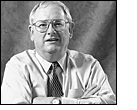 Kirk: Beyond Phase II, in addition to continuing to grow our business, we want to push the envelope on improving how multi-market semiconductor products are developed, manufactured and serviced. We plan to continue to improve our model for making and selling our products, increasing our productivity and efficiency over time. As our customer relationships expand, we will find more ways to innovate in product development and customer service. We still have tremendous opportunity open to us to utilize the Internet to speed our product development and accelerate the pace of our customer design wins. Kirk: Beyond Phase II, in addition to continuing to grow our business, we want to push the envelope on improving how multi-market semiconductor products are developed, manufactured and serviced. We plan to continue to improve our model for making and selling our products, increasing our productivity and efficiency over time. As our customer relationships expand, we will find more ways to innovate in product development and customer service. We still have tremendous opportunity open to us to utilize the Internet to speed our product development and accelerate the pace of our customer design wins.
Joe: Also, as we grow globally and tie our information systems more closely to our customers and suppliers, we see incredible potential for improving our logistics, our supply chain management and our ability to service a growing customer base. We’ve realized the main reason for our success over the past three years has been our focus on our customers, both by developing and selling new products, and servicing our customers better than some of our less-focused competition. The key to sustaining our growth and building our leadership in this segment will be improving the way we interact with our customers.
Kirk: We’re both excited about the future. We’ll grow by innovating and executing in product development,
manufacturing, and customer service. From day one these have been our cornerstones. We are now a $1.4 billion dollar company. We believe we can triple in size over the next five years. We have just begun.
|
 |
 |
 |
 |
 |
 |
 |
 |
|
 |
 |
 |
 |





 Kirk: Strategically, we want to expand our product portfolio, our regional sales coverage, and our end market penetration. Any business we acquire must fit these requirements. And, we would like to acquire manufacturing assets as part of any deal. That’s exactly what we did with our Raytheon and Power Device acquisitions. We’ve examined more than 100 opportunities over the last three years, and our effort continues. We have found that the most likely candidates are not publicly traded companies, but “carve-outs” of multi-market semiconductor businesses that are buried within larger semiconductor or electronics manufacturers. In many cases, these other companies have a strategic focus that doesn’t include investing in their multi-market products.
Kirk: Strategically, we want to expand our product portfolio, our regional sales coverage, and our end market penetration. Any business we acquire must fit these requirements. And, we would like to acquire manufacturing assets as part of any deal. That’s exactly what we did with our Raytheon and Power Device acquisitions. We’ve examined more than 100 opportunities over the last three years, and our effort continues. We have found that the most likely candidates are not publicly traded companies, but “carve-outs” of multi-market semiconductor businesses that are buried within larger semiconductor or electronics manufacturers. In many cases, these other companies have a strategic focus that doesn’t include investing in their multi-market products.
 Kirk: Beyond Phase II, in addition to continuing to grow our business, we want to push the envelope on improving how multi-market semiconductor products are developed, manufactured and serviced. We plan to continue to improve our model for making and selling our products, increasing our productivity and efficiency over time. As our customer relationships expand, we will find more ways to innovate in product development and customer service. We still have tremendous opportunity open to us to utilize the Internet to speed our product development and accelerate the pace of our customer design wins.
Kirk: Beyond Phase II, in addition to continuing to grow our business, we want to push the envelope on improving how multi-market semiconductor products are developed, manufactured and serviced. We plan to continue to improve our model for making and selling our products, increasing our productivity and efficiency over time. As our customer relationships expand, we will find more ways to innovate in product development and customer service. We still have tremendous opportunity open to us to utilize the Internet to speed our product development and accelerate the pace of our customer design wins.